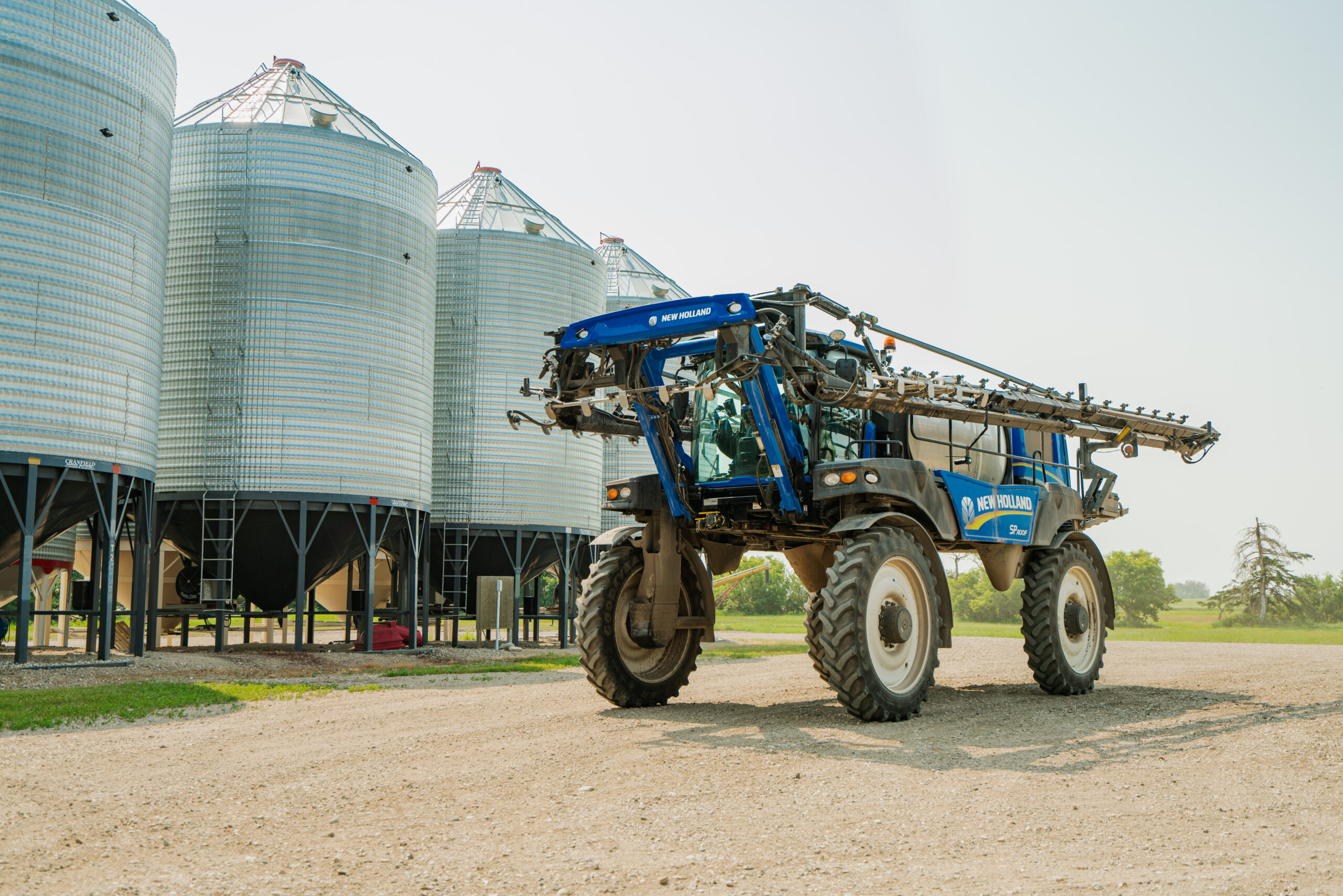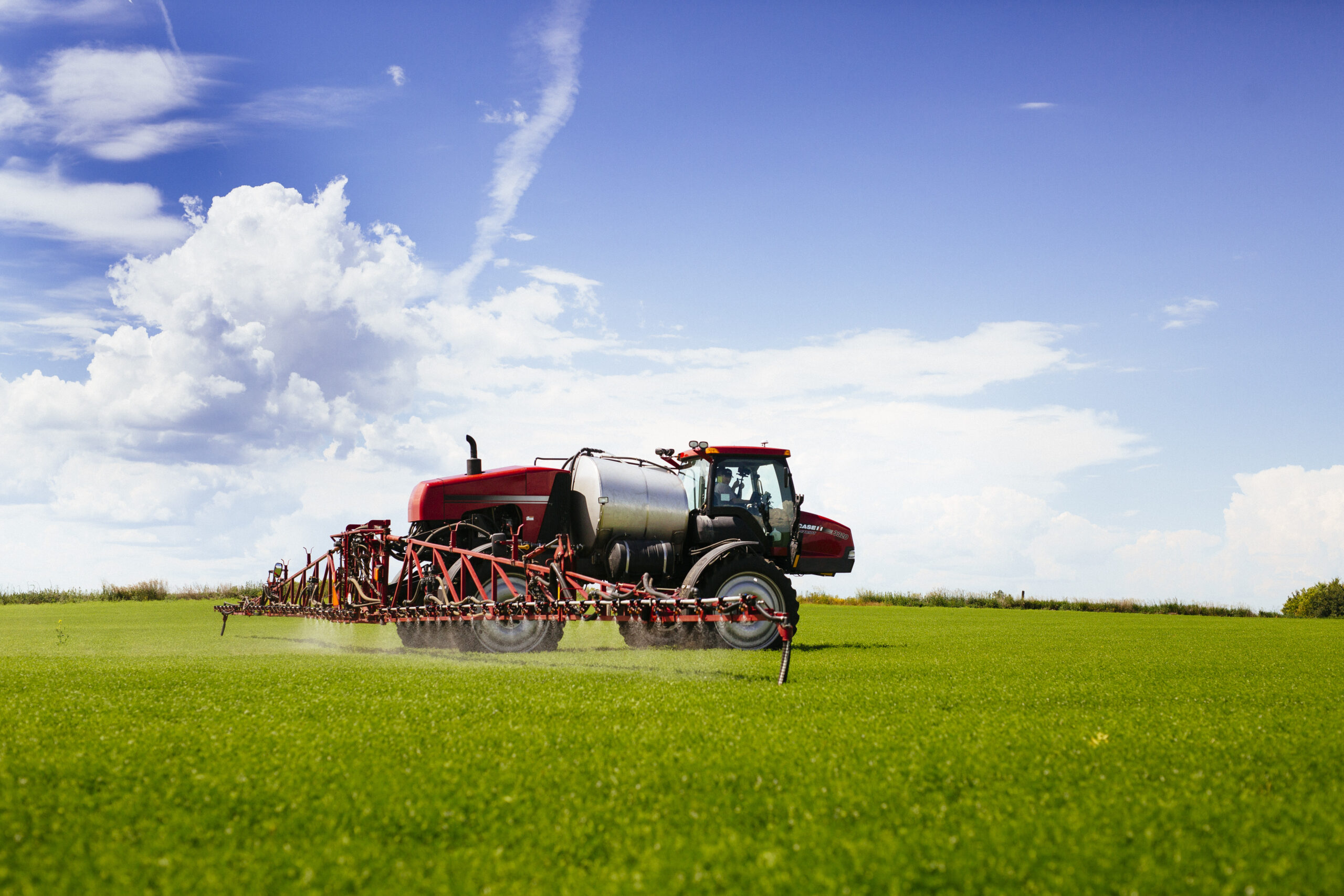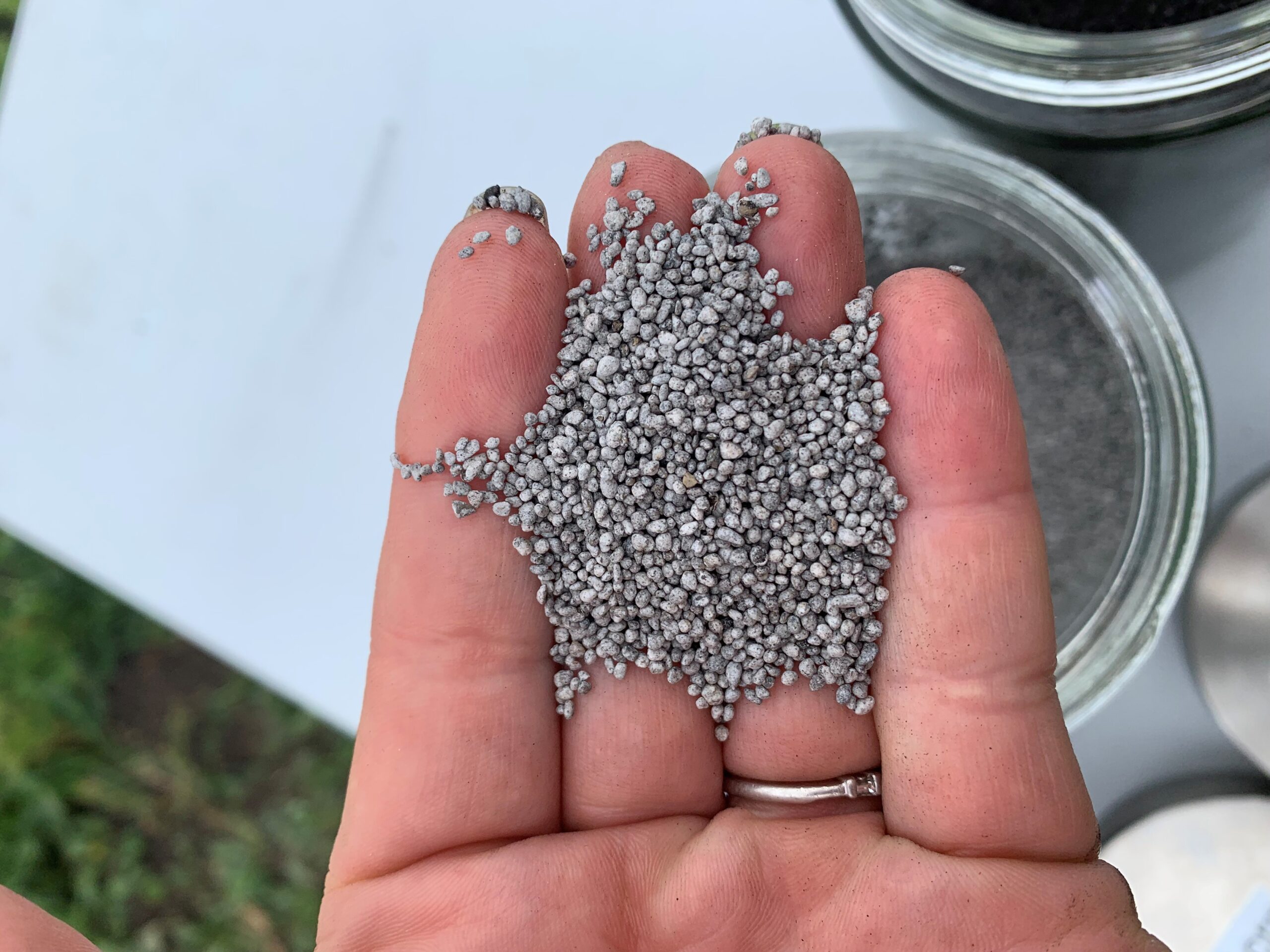By Jennifer Bogdan, PAg, CCA
Pulse crops can be very sensitive in their susceptibility to herbicides. Herbicide injury can result from herbicide drift, herbicide carryover in the soil, residual herbicides used at incorrect rates or on improper soil types, contamination of the sprayer tank or nozzle components, miscalibration of sprayer equipment, or sprayer overlap.
Symptoms of herbicide injury can be confused with symptoms caused by environmental or physiological stress on the plant such as frost, hail, or wind damage, excessive moisture, drought, heat stress, plant diseases, nutrient deficiency or toxicity, and fertilizer burn. Refer to Environmental Stresses in Pulses for more information.
Careful examination of the above and below-ground symptoms as well as detailed collection and analysis of all cropping information must be considered before determining the cause of an unhealthy plant.
Group 2 Herbicides
- Common active ingredients include imazamox, imazethapyr, imazapyr, flucarbazone sodium, metsulfuron-methyl, thifensulfuron-methyl, tribenuron-methyl, florasulam, pyroxsulam, and thiencarbazone-methyl.
- Group 2 herbicides can enter the plant through the roots (soil uptake) or can be absorbed through the leaves (foliar uptake). These herbicides move systemically through the xylem and phloem in the plant.
- Group 2 herbicides inhibit the production of branched-chain amino acids by targeting the acetolactate synthase (ALS) enzyme. This enzyme is most active in young meristematic tissue, so symptoms are found at the growing points of susceptible plants.
- Plant growth stops first, followed by chlorosis (yellowing) and then necrosis (browning and death) of the main growing point. Interveinal chlorosis (yellowing between the leaf veins) can also be seen with Group 2 injury.
- When the main growing point has been injured, secondary buds will “break” and begin to grow. The plant produces multiple shoots from its base, resulting in excessive branching or stooling.
- Excessive branching is commonly seen under situations where a sub-lethal dose of a Group 2 herbicide has inflicted enough damage to impede the main growing point, but not enough damage to kill the entire plant.
- Shortened internodes, stubby tendrils, and inhibition of root growth can also occur due to the effect of Group 2 herbicides on meristematic regions of the plant.
- Common causes of Group 2 injury in pulse crops are herbicide carryover (especially after a drier growing season the year prior and/or on soils where organic matter, texture, and pH are a factor), soil residual from an application on soils that fall outside the parameters listed on the herbicide label (organic matter, texture, and pH), spray drift, and sprayer tank residue.
- Group 2 products can be more challenging to clean out of the sprayer tank and components (booms, boom ends, nozzles, screens, and filters). Use recommended procedures and cleaning agents to carefully remove all Group 2 residue from the sprayer before making an application in sensitive crops such as pulses.
- Crop yellowing can occur with registered Group 2 herbicides as the plants have to metabolize the herbicide. This temporary “yellow flash” is more pronounced when cool temperatures occur around the time of application, when plants are stressed, and/or when the crop stage window is coming to an end.

Source: Jennifer Bogdan

Source: Emile deMilliano

Source: Jennifer Bogdan

Source: Jennifer Bogdan

Source: Clark Brenzil, Saskatchewan Agriculture

Source: Scott Anderson

Source: Jennifer Bogdan

Source: Eric Johnson, University of Saskatchewan

Source: Eric Johnson, University of Saskatchewan

Source: Eric Johnson, University of Saskatchewan

Source: Jennifer Bogdan

Source: Clark Brenzil, Saskatchewan Agriculture

Group 4 Herbicides
- Common active ingredients include 2,4-D, MCPA, dicamba, clopyralid, fluroxypyr, and halauxifen.
- Quinclorac is unique in its mode of action in that it acts as a Group 4 in broadleaf plants and a Group 26 in grassy plants. Because pulse crops are broadleaf plants, quinclorac is included as part of the Group 4 herbicides in this guide.
- Group 4 herbicides can enter the plant through the roots (soil uptake) or can be absorbed through the leaves (foliar uptake). These herbicides move systemically through the plant, primarily in the pholem.
- Group 4 herbicides mimic a plant growth regulator, called auxin, which is naturally found in low concentrations in plants. Among other roles in plant development, auxin is responsible for cell enlargement and division. The primary effect of these herbicides is that auxin-like activity becomes unregulated when the auxin binding sites of plants become saturated with Group 4 herbicide, resulting in uncontrolled growth. Secondary effects of the auxin imbalance induced by Group 4 herbicides include increased production of abscisic acid (ABA), which triggers plant senescence, and increased ethylene, which ultimately kills the plant. The plant “growing itself to death” is typically used to describe the activity of Group 4 herbicides, where there is unregulated growth from the auxin imbalance, followed by a stop in growth (from ABA) and eventual chlorosis and necrosis (from ethylene).
- Symptoms include twisting and bending of stems as well as stem swelling, particularly at the nodes. Leaves will appear cupped and curled, often with abnormal shape and venation. Excessive adventitious roots may form on the main root or in the leaf axils. Eventually the growing point will turn yellow, and the plant will wilt and die.
- A sub-lethal dose can cause puckering of young leaves, and new leaf tips may appear claw- or finger-like.
- Dicamba injury to non-tolerant soybeans often causes extreme cupping of the young, upper trifoliate leaves. In general, Group 4 injury to soybean leaves is very symmetrical, meaning the injury on all three leaflets of a single leaf will appear the same.
- Common causes of Group 4 injury to pulse crops are herbicide carryover in the soil (especially following a drier growing season) and spray drift.

Source: Jennifer Bogdan

Source: Jennifer Bogdan

Source: Clark Brenzil, Saskatchewan Agriculture

Source: Eric Johnson, University of Saskatchewan

Source: Eric Johnson, University of Saskatchewan

Source: Sherrilyn Phelps, Saskatchewan Pulse Growers


Source: Jennifer Bogdan
Group 5 and 6 Herbicides
- Common active ingredients include metribuzin (Group 5), bentazon (Group 6), and bromoxynil (Group 6). Linuron has been reclassified as a Group 5 herbicide (previously a Group 7).
- Group 5 herbicides can enter the plant through the roots (soil uptake) or through the leaves (foliar uptake).
- Group 6 herbicides enter the plant primarily through the leaves (foliar uptake). Soil uptake is not generally a concern.
- Group 5 and 6 herbicides inhibit photosynthesis by producing a build-up of toxic oxygen radicals to levels beyond what the plant can normally detoxify. These radicals subsequently cause proteins to stop working and cell membranes to become leaky. Group 5 and 6 herbicides all affect the same part of the photosynthetic pathway (photosystem II) but act on different sites of PS II, thereby separating them into their designated herbicide groups. Symptoms produced by Group 5 and 6 herbicides are all the same.
- Because these herbicides are water soluble, they move easily through the xylem (where water moves through the plant) to the leaf margins where symptoms first appear. Older leaves show symptoms sooner than younger leaves. Initially, intra-veinal chlorosis (yellowing between the veins) will appear near the edges of the leaf. Eventually the tissue appears bleached, desiccated, and “burned-off”.
- Because these herbicides affect photosynthesis, they require sunlight for activity. Symptoms will develop fastest if the application was made during or just prior to bright, sunny conditions.
- Even if a particular herbicide is registered for use on a particular pulse crop, symptoms such as yellowing, speckling, browning, or bronzing can occur. The crop typically outgrows this injury in 10 to 14 days.
- Metribuzin (Group 5) injury is most often observed with crop tolerance issues from soil residual or foliar applications. Crop tolerance decreases under stressful growing conditions such as drought, heavy rainfall on soils low in organic matter, high temperatures after application, and/or cold, cloudy weather or frost after application.
- A potential cause of linuron (Group 5) injury is from herbicide carryover, especially in lighter texture (sandier) soils low in organic matter.
- Because bentazon and bromoxynil (both Group 6) have little to no soil residual, the most potential cause of Group 6 injury is from spray drift. Dry bean varieties vary in their individual tolerance to bentazon.

Source: Brianna Zoerb, University of Saskatchewan

Source: Brianna Zoerb, University of Saskatchewan


Source: Eric Johnson, University of Saskatchewan

Source: Sherrilyn Phelps, Saskatchewan Pulse Growers

Source: Rick Holm, University of Saskatchewan
Group 9 (glyphosate)
- Glyphosate enters the plant through the leaves (foliar uptake) and moves systemically throughout the plant, primarily in the phloem.
- Glyphosate inhibits the 5-enolpyruvylshikimate acid-3-phosphate synthase (EPSPS) enzyme, which interferes with the production of aromatic amino acids, thereby causing a build-up of toxic intermediate compounds and interruption of pathways leading to plant death.
- Symptoms are slow to appear but are first noticeable at the growing points and in young leaves of susceptible plants. Chlorosis (yellowing) is followed by necrosis (browning) and tissue death.
- Because glyphosate is easily “tied up” in the soil, injury due to herbicide carryover or soil residual following a pre-seed or post-seed burn-off is not a concern. Rather, glyphosate injury to pulse crops is more likely to occur from spray drift or from a late post-seed burn-off application when the crop has already begun to emerge (ground-crack).
- A common misconception is that plants at ground-crack are “still living off the seed” and therefore will not “take in” the glyphosate. However, glyphosate is carefully formulated with adjuvants and carriers that are extremely effective in getting the glyphosate active ingredient into the plant. If glyphosate touches the plant, there is a high likelihood it will enter the plant. Furthermore, spraying at ground-crack can be deceiving as there are likely more plants emerging, and therefore at risk of injury, than what there appears to be.
- Glyphosate injury in pulses can also occur from using seed harvested from crops that received a pre-harvest application of glyphosate. Glyphosate moves with the sugars in the plant and can move into the seeds if applied when the seed moisture levels are too high. The result is decreased seed germination and the formation of abnormal seedlings. A germination test of seed intended for planting will detect any abnormal seeds that have been injured from chemical or mechanical damage.

Source: Emile deMilliano

Source: Emile deMilliano

Source: Jennifer Bogdan

Source: Jennifer Bogdan

Source: Jennifer Bogdan

Source: Jennifer Bogdan
Group 10 (glufosinate ammonium)
- Glufosinate is a contact herbicide that enters the plant through the leaves (foliar uptake).
- Glufosinate inhibits the enzyme glutamine synthetase, causing a cascade of negative reactions in the plant that eventually lead to the build-up of toxic oxygen radicals in the chloroplasts, where photosynthesis takes place. These radicals break down the lipid cell membranes causing rapid cell death and, consequently, the quick appearance of symptoms, especially under high light (sunny) conditions. Ammonia also accumulates in the plant, contributing to plant death. However, it is the build-up of oxygen radicals in the photosynthetic pathway that is responsible for the fast action of glufosinate.
- Symptoms include greyish-white bleached patches on the tissue, yellowing, and wilting. Symptoms appear quickly in one to three days following application and are more pronounced under sunny conditions. Plant tissue death occurs in one to two weeks.
- Because glufosinate is rapidly degraded by soil microbes, soil uptake or herbicide carryover is not a concern. A potential cause of Group 10 injury is spray drift, although drift damage from glufosinate is not likely to be as severe as drift from a systemic herbicide, such as Group 2 or 4.
Group 14 Herbicides
- Common active ingredients include carfentrazone, sulfentrazone, flumioxazin, pyraflufen-ethyl, and saflufenacil.
- Group 14 active ingredients vary widely in their uptake properties (foliar, soil), translocation abilities (contact, systemic), and registered uses (pre-seed soil residual, post-seed foliar, pre- harvest aid).
- Group 14 herbicides inhibit the protoporphyrinogen IX oxidase (PPO) enzyme in the chloroplast, preventing the production of chlorophyll and other components involved in the photosynthetic pathway. An intermediate molecule builds up and upon exposure to light, it reacts with oxygen to form singlet oxygen which acts on the lipids in cell membranes. When the singlet oxygen moves away, it tears the membrane, causing it to leak and photosynthesis stops.
- Plants appear water-soaked and become wilted. The tissue then browns and dies. Affected tissue appears bleached. Symptoms appear quickly (within hours) after application and Group 14 activity increases under conditions that favour photosynthesis (more sunlight, higher temperature, and higher humidity). Plant death occurs within a few days of application.
- Many Group 14 herbicides are registered for use on pulse crops. To avoid application errors, individual herbicide labels must be consulted as the specific pulse crops, usages, and rates may differ between products.
- Injury to lentil seedlings (pinched hypocotyl) can result from high-rate application of saflufenacil. Only the low rate is registered for use before lentils. Lower rates of saflufenacil are also recommended for soybeans to reduce the risk of crop injury.
- Root uptake of saflufenacil in lentils as a result of rainfall shortly after spring burn-off can result in slight injury. Injury will appear as burning on the outer edges of the leaves (those present at the time of herbicide uptake), but the plants will grow out of the symptoms with little or no impact on yield. Lentils are more susceptible on coarse-textured (sandy or gravelly) and low organic matter soils.
- Group 14 injury to pulse crops can also occur from spray drift (foliar active ingredients) or from reduced crop tolerance with soil residual products under certain conditions.
- In order to lessen the risk of Group 14 crop injury, careful attention must be directed to the specific soil parameters that impact each active ingredient. For example, when sulfentrazone is applied to coarse-textured (sandy) soils, crop injury may occur if a heavy rainfall leaches the chemical into the rooting zone. Conversely, when flumioxazin is applied to soils where a heavy rainfall can cause water to pool, a high concentration of chemical can form in the soil solution and injure the emerging plant shoot. Crop injury from herbicides will be exacerbated under stressful growing conditions (temperature extremes, high winds, very shallow or very deep seeding, or compaction).

Source: Eric Johnson, University of Saskatchewan

Source: Eric Johnson, University of Saskatchewan

Source: Brianna Zoerb, University of Saskatchewan

Source: BASF
Group 15 Herbicides
- Common active ingredients include pyroxasulfone and metolachlor.
- Group 15 herbicides are soil residual herbicides applied before seeding and enter the plant through root uptake.
- Group 15 herbicides inhibit the formation of very long chain fatty acids. As a result, cell division and expansion is reduced and growth at the main growing point stops.
- Group 15 herbicides require rainfall to activate the chemical. The active ingredient is taken up by newly germinated seedlings through the coleoptile (in grassy plants) and the roots. Beyond the seedling stage, plants can translocate the chemical from the roots to the shoots.
- Most susceptible plants do not emerge from the soil. Emerged plants appear malformed and twisted. Leaves of broadleaf plants can be cupped or crinkled.
- Although registered for use before seeding lentils, pyroxasulfone can affect lentil growth under conditions of high pH (≥7.5), cool weather, excessive moisture, salinity, seedling diseases, and other unfavourable growing conditions. Lentil injury symptoms in these cases can appear as leaf cupping, stunting, and purpling.
- Crop tolerance to Group 15 herbicides can also be reduced if the crop is seeded too shallow.
- Dry bean varieties vary in their tolerance to metolachlor. New varieties should first be tested on a limited acreage.

Source: Eric Johnson, University of Saskatchewan

Source: Eric Johnson, University of Saskatchewan
Group 22 (diquat)
- Diquat is strictly a contact herbicide that enters the plant through the leaves (foliar uptake). There is no residual soil activity with diquat.
- Diquat is a photosystem I (PS I) inhibitor and works by diverting electrons to oxygen, creating toxic oxygen radicals that disrupt proteins and lipids. Cell membranes become leaky and plant tissue dries up before dying. The fast activity of diquat makes it useful as a crop desiccant.
- Initial symptoms of wilting, spotting, and interveinal chlorosis (yellowing) appear as soon as a few hours after application under sunny conditions. Plant tissue appears bleached and eventually turns brown and/or black as plant death occurs.

Source: Rick Holm, University of Saskatchewan
Group 27 Herbicides
- Common active ingredients include pyrasulfotole and topramezone.
- Group 27 herbicides primarily enter the plant through the leaves (foliar uptake) and move systemically within the plant (xylem mobile).
- Group 27 herbicides inhibit the 4-hydroxyphenylpyruvatedioxygen- ase (HPPD) enzyme, which interferes with photosynthesis and carotenoid (plant pigment) production. Vitamin E synthesis, which protects cell membranes from oxidative stress, is stopped and chlorophyll is destroyed as a result.Symptoms include bleaching (whitening) of the new leaves, beginning at the leaf margins, and plant tissue due to the destruction of chlorophyll. Plant death occurs in one to two weeks.
- Soil characteristics (organic matter, pH) can influence the persistence of Group 27 herbicides, especially pyrasulfotole. As such, injury to pulse crops can result from herbicide carryover in certain soil types. Spray drift can also cause Group 27 injury in pulses.

Source: Sherrilyn Phelps, Saskatchewan Pulse Growers

Source: Sherrilyn Phelps, Saskatchewan Pulse Growers


Source: Jennifer Bogdan


